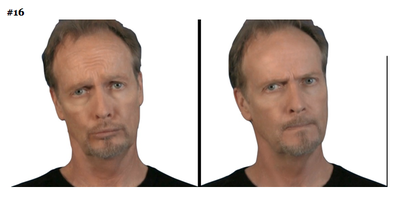Emotion Gallery
Click on the photo you want to learn more about.
Register for the next Free Webinar |
7 Universal Emotions (Click on Photo to enlarge) |

In the late 1960’s, Dr. Paul Ekman came on to the scene. Ekman’s research into emotions and their relation to facial expressions renewed Darwin’s theories and took his work to a whole new level. Studying a remote tribe in the highlands of Papua, New Guinea, Ekman discovered that these tribesmen, who were never exposed to the outside world, not only expressed surprise, fear, anger, disgust, sadness, and happiness with the same muscle groups and patterns, but for the same reasons as the rest of the world. This study revealed that these 6 emotions were biological in origin and universal across all cultures. Contempt later became the seventh emotion to be added to the list.
How often have you heard that casting directors and directors “know it when they see it?” They know it because they can recognize it.
The recognition of these unique facial muscles when someone becomes emotional is responsible for your understanding of the Language of the Face. Without a word spoken, we’re able to pick up facial cues from others that tell us if they are upset, frightened, confused, or feeling happy. The same is true in film and television, where we can see what the actor is feeling or thinking just by ‘reading’ his or her face. Although it can be quite subtle, we can identify the moment when an actor becomes emotional – simply by the recognition of one or more of the emotional facial muscle groups appearing or leaving his or her face.
Think of the 7 universal emotions in the same way you think of the 3 primary colors. By blending these 3 primary colors in different combination and amounts, you can come up with an infinite amount of colors. The same is true for the 7 emotions.
Macro (Click on Photo to enlarge) |
This is a full intensity emotional facial expression that appears when there is no need to manage or hide the emotion in any way. Macro expressions last longer and are more emotionally intense than other kinds of expressions. Macro expressions often involve the whole face and are expressed with all the muscle groups. The photos of the 7 Universal Emotions are macro expressions.
Subtle |
|
|
This is a full expression of an emotion that for one reason or another is trying to be concealed. Micro expressions are very quick – usually less than half a second. Recognition of what emotion was expressed is typically missed by the average person, yet you can instinctively tell something has happened. These expressions can be seen when you freeze a frame of a film or TV show. Although they’re quick, if they’re used skillfully, they can open the door to a whole new level of revealing character thoughts and feelings to the viewer.
|
Cognitive- Emblem (Click on Photo to enlarge) |
Cognitive refers to thinking. Some thinking doesn’t take a lot of energy – it just causes us to slow down or stop what we’re doing in order to solve a problem, or to simply daydream. But when the problem is more difficult or perplexing, we need focus. If that’s the case, believe it or not, we often turn to the anger family. For example, the brows may pull in and down or there may be more tension in the eyes as you focus in on something. Or you may press your lips together or jut your jaw out slightly (see photo #15 left side). This is why a lot of people look angry when all they are doing is thinking.
Emblems, on the other hand, are symbols that are culturally recognized. For example, saying everything is okay by giving a ‘thumbs up.’ Or saying everything is not okay by giving someone the middle finger. When you lift your brows up and hold them in that position, it is an emblem for questioning (see photo #15 right side). If the head tilts down slightly, it can read like doubt or slight skepticism. We use our eyebrows to communicate a lot. They can be a sign that you’re alert and open – or even just a way of saying hello.
Emblems, on the other hand, are symbols that are culturally recognized. For example, saying everything is okay by giving a ‘thumbs up.’ Or saying everything is not okay by giving someone the middle finger. When you lift your brows up and hold them in that position, it is an emblem for questioning (see photo #15 right side). If the head tilts down slightly, it can read like doubt or slight skepticism. We use our eyebrows to communicate a lot. They can be a sign that you’re alert and open – or even just a way of saying hello.
Emotional Emblems (Click on Photo to enlarge) |
Emotional emblems look like the facial expression of the emotion, but are different enough for the viewer to know that you are not really feeling what you are showing. It’s like feigning or mocking someone’s anger with a sad expression or warning them that you will get angry if they overstep a boundary (see photo #16 below). You might also let someone know how you feel or how you’re going to feel. For example, you’re telling a friend that you have to go see your accountant about taxes, then right after you tell him, you tense your lips and stretch your lips back and down. The person you’re talking to will recognize the emotional symbol and knows that fear is coming from what will happen, not what you are feeling at that moment.











